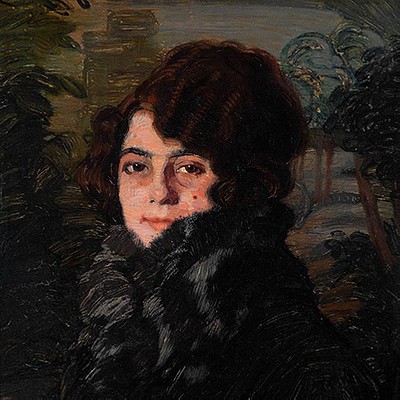MARIANO BERTUCHI NIETO (Granada, 1884 - Tetuan, 1955). "Tetuan". Oil on cardboard. Signed and located in the lower right corner. Measurements: 32 x 40
Lot 70
About Seller
Setdart Auction House
Carrer Aragó 346
Barcelona
Spain
Setdart Subastas was born in 2004 and is currently the first online art auction in Spain with solidity, prestige and reliability guaranteed by our more than 60,000 users. Setdart has a young, dynamic and enterprising team ready to successfully manage the purchase and sale of art works through custom...Read more
Estimate:
EUR€10,000 - EUR€12,000
$10,416.67 - $12,500
Absentee vs Live bid
Two ways to bid:
- Leave a max absentee bid and the platform will bid on your behalf up to your maximum bid during the live auction.
- Bid live during the auction and your bids will be submitted real-time to the auctioneer.
Bid Increments
| Price | Bid Increment |
|---|---|
| EUR€0 | EUR€10 |
| EUR€200 | EUR€25 |
| EUR€500 | EUR€50 |
| EUR€1,000 | EUR€100 |
| EUR€3,000 | EUR€200 |
| EUR€5,000 | EUR€500 |
| EUR€10,000 | EUR€1,000 |
| EUR€20,000 | EUR€2,000 |
| EUR€50,000 | EUR€5,000 |
About Auction
By Setdart Auction House
Jul 15, 2021
Set Reminder
2021-07-15 08:00:00
2021-07-15 08:00:00
America/New_York
Bidsquare
Bidsquare : 19th & 20th CENTURY PAINTINGS & ORIENTALISM
https://www.bidsquare.com/auctions/setdart-auction-house/19th-20th-century-paintings-orientalism-7212
Setdart Auction House sofia@setdart.com
Setdart Auction House sofia@setdart.com
- Lot Description
MARIANO BERTUCHI NIETO (Granada, 1884 - Tetuan, 1955). "Tetuan". Oil on cardboard. Signed and located in the lower right corner. Measurements: 32 x 40 cm: 53 x 62 cm (frame). Urban view of the city of Tetuan, concretely of the door of the wall, which gives way to the Medina of the city. Bertuchi has captured a scene where the pinkish light indicates that it is the first moments of the day. A light that gives the image a relaxed and soft atmosphere, presenting the subject in an idyllic way. Through the use of a quick, impostor brushstroke, the artist gives great prominence to colour and light. He creates a play of light and shadow in the composition that manages to contextualise the viewer in this orientalist atmosphere. Known as "The great painter of the Protectorate" or "The painter of Morocco", Mariano Bertuchi is known for his style of painting, Orientalism, which was born in the 19th century as a consequence of the Romantic spirit of flight in time and space.Bertuchi trained in Granada, as a disciple of García Guerra and de Larrocha, and later entered the School of Fine Arts. In 1895, at the age of eleven, he took part for the first time in an exhibition and two years later won the first prize of his career. In 1899, at the age of fifteen and after his first trip to North Africa, Bertuchi presented three works in Granada and then moved to Madrid to continue his studies. That same year he presented his work in Madrid at the Biennial of the Círculo de Bellas Artes. From the beginning of the century Bertuchi took part in exhibitions at the Círculo de Bellas Artes in Madrid and also showed his work in Granada. In 1903, at the age of nineteen, he became a graphic reporter of the Moroccan Civil War, producing ten oil paintings on cardboard which were published in "La Ilustración Española y Americana". In 1908 he returned to Malaga to produce a series of paintings on military themes. Shortly afterwards he went to Melilla, then besieged by the Sultan's imperial troops, to make a series of sketches of their camp. In 1911 he settled in San Roque, Cadiz, and two years later, before the Spanish troops entered Tetouan, he made sketches for his painting "Entry of H.I.H. the Khalifa Muley-el Medhi into Tetouan". In 1918 Bertuchi settled in Ceuta, and from his early years there he made advertisements for the Ceuta-Tetuan Railway, a collaboration that would last for twenty years. It was also in Ceuta that he designed the sketches for the stained-glass window of the main staircase of the Town Hall, and painted a general view of Ceuta which is to be found in the former mayor's office. In 1921 he painted a triptych dedicated to Commerce, Agriculture and Industry for the Casino Africano in the same city, and the following year he took part in the decoration of the Municipal Palace, executing the paintings of the Royal Sites that adorn the Throne Room. After several years in Ceuta, he finally settled in Tetuan in 1928, where he was appointed Inspector of the Fine Arts and Crafts Services of the Moroccan protectorate. By then he was already a member of the San Fernando Royal Academy of Fine Arts in Madrid. He was also director of the Schools of Arts and Crafts in Tetuan and Targuist, as well as the Moroccan Ethnographic Museum. In 1935 he received the Order of Alfonso X the Wise. Mariano Bertuchi is currently represented in various museums in Ceuta and several Moroccan cities.
- Shipping Info
-
In-house shipping available. Please inquire at admin@setdart.com.
-
- Buyer's Premium



 EUR
EUR CAD
CAD AUD
AUD GBP
GBP MXN
MXN HKD
HKD CNY
CNY MYR
MYR SEK
SEK SGD
SGD CHF
CHF THB
THB

















